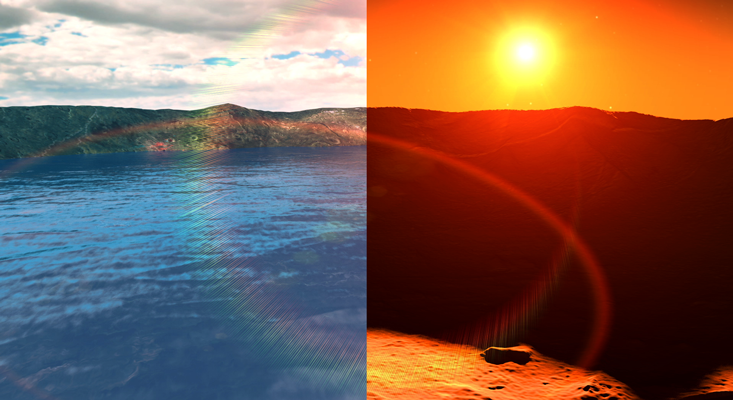It seemed inevitable that Elon Musk would eventually get into a Twitter war over whether Mars can be terraformed. When you’re on Twitter, he told Businessweek in July, 2018, you’re “in meme war land.” “And so essentially if you attack me,” he said, “it is therefore okay for me to attack back.”
Musk, the CEO and lead designer of SpaceX, wants to “make life multiplanetary,” starting with Mars. “Public support for life on Mars is critical to making it happen,” he tweeted last week. The red planet is relatively close to the Earth and once harbored surface seas and rivers, and it still has ice and a subsurface lake. Its weather is surprisingly workable, too. Mars’ surface temperature range (–285 to 88 degrees Fahrenheit) isn’t too far off from Earth’s (–126 to 138 degrees Fahrenheit). The problem is Mars’ atmosphere now has 0.006 bar of pressure, where one bar is the standard atmospheric pressure at sea level on Earth. Not only does this mean that dangerous levels of radiation reach the surface unchecked, but humans need at least 0.063 bar to keep our bodily liquids from boiling (this is called the Armstrong limit).
Enter terraforming—changing a planet’s climate, topography, or ecology to be more suitable for life. If we could boost the pressure of Mars’ atmosphere just above that of Mount Everest’s summit (0.337 bar), we could walk on the Martian surface using just a breathing mask—no pressurized space suit required. That might be called weak terraforming: It wouldn’t let plants grow in the soil outside of greenhouses.

For that, a good amount of nitrogen, more than scientists have spotted so far on Mars’ surface, is required. It also wouldn’t let us breathe the Martian air. But Musk thinks that, at the least, weak terraforming is possible: “In fact,” he told an audience at the International Astronautical Congress in Mexico in 2016, “if we could warm Mars up, we would once again have a thick atmosphere and liquid oceans.”
But is it?
No—not any time soon. At least, that’s according to the latest look at the idea from NASA’s principal investigator for the Mars Atmosphere and Volatile Evolution (MAVEN) spacecraft, Bruce Jakosky, a space scientist at the University of Colorado, Boulder. He says the growing popularity of terraforming—driven in part by Musk—persuaded him and Christopher Edwards, a geologist also at Boulder, to gauge whether it was feasible. Their answer: No, it “is not possible using present-day technology.” In their July 2018 Nature Astronomy paper, they mention Musk directly, shooting down his idea of terraforming by nuking Mars’ polar ice caps. The amount of frozen CO2 released would not be enough to induce a runaway greenhouse effect, they argue. Shortly afterward, Discover magazine singled out Musk in a tweet linking to the headline: “Sorry, Elon. There’s Not Enough CO2 to Terraform Mars.”
So Musk counter-attacked. “There’s a massive amount of CO2 on Mars adsorbed into soil that’d be released upon heating,” he tweeted at Discover. “With enough energy via artificial or natural (sun) fusion, you can terraform almost any large, rocky body.” The next day on Twitter, Musk replied twice to a Discover tweet rebutting his comment. First, he tweeted, in part: “Oh yeah? I’ll see ur expert & raise you a Chris McKay @NASA.” Then, three minutes later: “Science” followed by an emoji heart, microscope, shooting star, and a link to a 1993 paper McKay co-authored, titled “Technological Requirements for Terraforming Mars.”
If Mars has lost 75 percent of its atmospheric CO2 to space, then barely any of it has been stored in the ground near enough to the surface for humans to be able to mobilize it.
Why would Musk put his trust in McKay, a NASA Ames Research Center planetary scientist, over other experts? I asked McKay if he’d seen Jakosky and Edwards’ Nature Astronomy paper. The paper notes that MAVEN, since 2014, and the Mars Express spacecraft, since 2003, have observed Mars lose part of its atmosphere to space in real time, and that the Mars Reconnaissance Orbiter and the Mars Odyssey spacecraft have analyzed the “abundance of carbon-bearing minerals and the occurrence of CO2 in polar ice.” These new data points, they say, indicate that, first, the majority of Mars’ ancient, thick atmosphere has been lost to space, not transferred back into still-undetected shallow reservoirs of CO2 beneath the surface; and second, that whatever amount of CO2 is left in the ground, it is “not accessible and thus cannot be readily mobilized” into the atmosphere.
“I know this paper,” McKay said, “They are correct that, indeed, the key question for terraforming is the amount of CO2, N2, and H2O on Mars. Unfortunately there is nothing new here to resolve this question.” In McKay’s opinion, the new data that Jakosky and Edwards point to just isn’t good enough.
McKay drew my attention to a 1991 paper he wrote in Nature with two colleagues, Owen Toon and James Kasting, titled, “Making Mars habitable.” What he concluded then—about how the amount and distribution of carbon dioxide, water, and nitrogen on Mars is unclear—is still true today, he told me. “We are still highly uncertain as to the amount of CO2 below the surface. We don’t have good data and will need to drill deeply to get it.” He said Jakosky and Edwards’ conclusion that near-term terraforming is impossible is “premature.”
He isn’t alone in this view. McKay is joined by Robert Zubrin, his co-author on the 1993 terraforming paper. Zubrin is an aerospace engineer, author, and founding president of the Mars Society, a non-profit which advocates terraforming Mars. Building a civilization there would “add to the strength and vitality of human culture” on Earth, Zubrin told NBC News. He has also argued that Mars should be the goal of NASA’s space program.
Ask Zubrin what he makes of Jakosky: He is “not only pretending to knowledge he doesn’t have, but which is in flat contradiction to the known data.” For example, the results Jakosky highlighted in his Nature Astronomy paper indicate that at least 75 percent of ancient Mars’ atmospheric CO2—0.5 bar of it—floated away billions of years ago, possibly driven out by solar wind and extreme ultraviolet light, among other things. If Mars has lost at least 75 percent of its atmospheric CO2 to space, then that means barely any of that early thick atmosphere—amounting to less than a bar, according to Jakosky—has been stored in the ground near enough to the surface for humans to be able to mobilize it. “Obviously,” Jakosky and Edwards write, “once gas has been lost to space, it is no longer available to be mobilized back into the atmosphere.” To them that leaves only a paltry amount of accessible CO2 left in the ground: 0.020 bar.
Jakosky calculates that 75 percent loss in the following way: Assume the solar-wind and UV-light activity observed today also operated in the past but with greater intensity (something he believes to be true, based on a history of the sun derived from sun-like stars). Then, take the ratio today of carbon 13 to 12 in the Martian atmosphere, and compare it to the ratio of carbon 13 to 12 in the ground. Since the heavier isotopes in the atmosphere tend to stick around, while the lighter ones fly away, the degree to which atmospheric CO2 is enriched with the heavier isotope will differ relative to ground-based carbon. That difference indicates, Jakosky and Edwards write, that at least three-quarters of Mars’ atmospheric CO2 is gone and that “loss to space was the dominant process for removing the ancient CO2 greenhouse atmosphere.” This is opposed to the idea, backed by Zubrin and McKay, that another process could have removed CO2 from the atmosphere but kept it on the planet—either adsorption into the soil, freezing as CO2 ice, or getting locked up in carbon-bearing minerals.

This is where, to Zubrin and McKay, Jakosky seems to contradict the known data. 0.5 bar of atmospheric CO2 loss is a fair—even if not conclusive—assessment, McKay and Zubrin told me. (McKay: “There is some debate if they are actually measuring CO2 loss or just O2 loss.” Zubrin: “That claim is controversial, but we’ll let it pass because at least in that case [Jakosky] is arguing from data.”) What they disagree with is Jakosky’s carbon isotope analysis. Zubrin said it is impossible for the 0.5 bar of atmospheric CO2 loss to represent 75 percent or more of Mars’ original atmospheric total because, “based on the available data on liquid water on ancient Mars, Mars must have had at least 2 bar of CO2” enveloping the planet (the ground-based amount at that time is unknown). If so, contrary to Jakosky, there would be well over a bar left in shallow ground deposits somewhere—enough to trigger a runaway greenhouse effect if vaporized.
Plus, Zubrin pointed out, scientists don’t know what the original carbon 12 to 13 ratio of the planet was, which Jakosky more or less concedes in his paper. (He extrapolates the ratio on ancient Mars from Martian meteorites.) Most importantly, Jakosky “doesn’t know what the C12/C13 ratio in the subsurface soil is,” Zubrin added. “It could be very different from the atmospheric ratio, because if most of the CO2 was immobilized in the regolith”—the layer of unconsolidated rocky material covering bedrock—“billions of years ago, while most of the atmosphere was lost to space, the two reservoirs would be left with entirely different contents.” McKay echoed this. “The isotope data only refers to the carbon reservoirs that exchange with the atmosphere,” he said. “Carbonate rocks and CO2 ice deposits that are isolated from the atmosphere will not be indicated by the carbon isotope ratio at the surface.”
The ice cap at the South Pole, for example, is one region harboring isolated deposits. “These are not well understood nor is their extent fully determined,” McKay said. He pointed out a 2016 study, in which scientists mapped what they could of the region remotely, using the Shallow Radar instrument on Mars Reconnaissance Orbiter, and found that there’s enough subsurface CO2 ice to double Mars’s atmospheric pressure, to 0.012 bar, if it were vaporized.
Of course, that’s nowhere near a sufficient amount to allow humans to walk on Mars without a pressurized suit. Many more deposits of CO2 capable of being released into the atmosphere must be found. The deposits at the South Pole “are relatively young,” McKay said. “But old, deeper deposits may exist.” For him, the results from the MAVEN and Mars Express spacecrafts are “a plus” because “virtually all climate models suggest that early Mars must have had several bars of CO2 early in its history,” he said. “So there must be bars still left there” in shallow ground deposits, buried for billions of years.
Imagine someone on Mars, in 1890, estimating Earth’s oil reserves without ever having drilled there.
I put this to Jakosky. He replied he believes there’s almost no CO2 (about the equivalent of 0.020 bar) left on or near the surface that can be vaporized. This estimate is based both on his atmospheric CO2-loss analysis and on the fact that large amounts of CO2 haven’t been hinted at on the surface, which humans have probed to a depth of 10 centimeters. It also hasn’t been exposed in a half-dozen other locations—impact craters and massive trenches, like Valles Marineris, the Grand Canyon of Mars. These two types of surface features show layers of the crust at various depths.
So any buried CO2 must be deeper still, in hard-to-reach places. “You have to make assumptions about what you can’t see,” Jakosky told me. There might be a lot of buried, “deep carbonate” CO2 still left on Mars, but it can’t be reached. “While there is no formal upper limit on the amount of carbonate deposits—one could always argue that they are preferentially sequestered in locations that we have not or cannot observe—such deposits are both geologically implausible and difficult or impossible to access for terraforming,” he and Edwards write.
McKay’s takeaway from the same information is less pessimistic and less conclusive. “Unfortunately we have not learned much about the subsurface of Mars over the past 20 years. More data please,” he told me. “This planet is the size of Earth’s continents and appears very different in different locations.” Zubrin invited me to imagine someone on Mars, in 1890, estimating Earth’s oil reserves without ever having drilled there: “That’s the position Jakosky is in,” he said. “It’s ridiculous, absurd.”
If Jakosky is wrong, and Mars really does have multiple bar-equivalent of buried CO2 that we can access, we could potentially terraform Mars rapidly. “To judge from how quickly our greenhouse emissions are warming Earth, we could shift Mars into a warm climate state within 100 years,” McKay explained in his Nautilus feature. “The most efficient technique would be to produce supergreenhouse gases such as chlorofluorocarbons or, better, perfluorinated compounds, which are not toxic, do not interfere with the development of an ozone layer, and resist destruction by solar ultraviolet radiation. Curiosity has confirmed the presence of fluorine in the rocks on Mars, so the ingredients are all there.”
In a 2001 paper, McKay and aeronautical engineer Margarita Marinova, now the Senior Mars and Vehicle Systems Development Engineer at SpaceX, wrote, “On the order of 4×1020 Jules, equivalent to about 75 minutes of Martian sunlight, will be required to produce enough [perfluorocarbons] to raise the temperature of Mars” by about 9 degrees Fahrenheit. “This is equivalent to 250 facilities consuming 500 MW (the size of a small nuclear reactor) working for 100 years.” Lots of people will be needed to staff those facilities, in addition to those providing for the colony’s other needs, like agriculture. Zubrin believes that half a million to a million people will be needed to start substantial terraforming.
Whether we can terraform Mars or not, it does look like we’ll be visiting soon. Musk has a plan to get us there using SpaceX’s Starship. A few of them, after landing, will form “Mars Base Alpha.” In Australia, he showed it to an audience along with pictures depicting the growth of the base into a town and then a city. Eventually, Mars’ new inhabitants will terraform Mars, he said. It will be “a nice place to be.”
Brian Gallagher is an associate editor at Nautilus. Follow him on Twitter @bsgallagher.
This article first appeared in our “In Plain Sight” issue in October 2018.


























